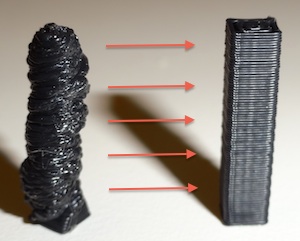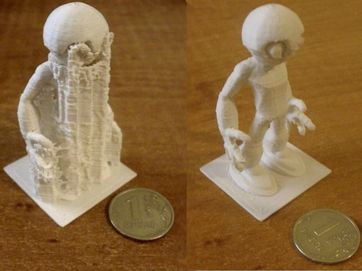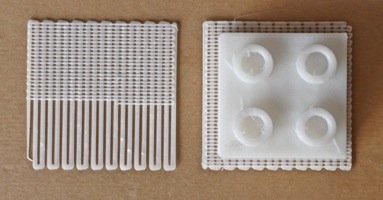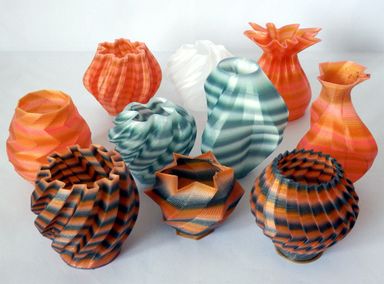10 myths about home 3D printing

Interest in 3D printing is growing every day. There are more and more people who at least have heard about the 3D-printer. More and more people who buy a 3D printer for themselves home. But home 3D printing is still buried in myths.
The situation is that now the vast majority of 3D printers for home use work on FDM technology. Therefore, all the myths will relate to this technology and relevant only at the time of this writing. The future is near, and the impossible today will be possible tomorrow.
So, 10 myths about home 3D printing, which I often hear
')
1. You can print anything
This is not entirely true. With proper skill, you can really print a lot, but there are limitations:
- Printing is limited by print resolution.
It is not possible to print small parts that are smaller than the nozzle size. In addition, there is a problem when the previous layer does not have time to cool down and a new one is put on top of it. Geometry of the object suffers from this. Partially this problem is solved by forced cooling of the previous layer with a stream of air.
- The dimensions and geometry of the object.
If the model has overhanging elements, then it is necessary to print supporting structures. The supports are quite difficult to remove if they are printed with the same material as the main model. It spoils the already not perfect surface.
It is also necessary that the model had a flat base, otherwise it will peel off from the surface of the desktop. If the base of the model is non-planar or very small in size, then the model is printed on a special substrate - rafts. Removing the raft also spoils the surface.
- Maximum dimensions of the print field.
There is a working field for printing. A model that exceeds the maximum print margins at a time cannot print. There is only one way out of this situation: you need to cut the model, print it in pieces and glue the printed pieces.
2. Can print assembly mechanisms
Mechanisms in the collection, such as a bolt on which the nut is screwed, really possible. But not for FDM technology. Not exactly the accuracy. The nut and bolt are fused together. It is much easier to print the same bolt and nut separately.
Although, there are models of cars with spinning wheels and a whistle with a ball inside, which is broken off with a screwdriver.
3. Full color printing
About full-color printing at home while you can forget. Printing with two (or more) colors is possible, but you need to either have several print heads, or change the bar during printing, or paint the bar itself. There are experiments on mixing colors, but they do not allow for a sharp color transition.

4. Printed part is fragile.
Of course, the printed model will be inferior in strength to the exact same cast model.
The strength of the printed part depends on where the force is applied: along the layers or across. In general, it resembles wood, the strength of which also depends along or across the fibers, force is applied.
In addition, the strength depends on the percentage of casting the part. The printed “cube” 20x20x10mm with 100% casting is quite difficult to break with a hammer. In addition, everyone heard about the printed gun.
5. Printed models do not need processing.
The surface of the printed model is not perfect at all: burrs, ribbing, sagging. For smoothing the surface, mechanical (sanding, cutting burrs) and / or chemical treatment (solvent bath) are used.

6. Waste-free technology
Unlike a milling cutter, waste is significantly less. After all, an object is created not by removing excess material from a single piece, but by building it up.
Still, the waste will still be:
- Plastic tends to flow out of the nozzle when idle
- The reject rate can be very high (especially at the beginning of the path of the 3D printer)
- When the plastic reel ends, the tail remains that is not enough to print something useful.
- Supports, underlays, skirts, which are then cut from the printed model
7. Printer is cheap or expensive
Of course, it is much cheaper to assemble the printer yourself. It is quite possible to keep within 15-25 thousand rubles. But this option is suitable for those who have time. Since Some parts will have to be ordered from abroad.
Printers are assembled by hand in particular because of this they are expensive. But the cost falls and will continue to fall.
Again, everyone has different opportunities and for someone 40 thousand rubles. not money.
8. Everything is simple! Connect and print
This is the biggest misconception. Whatever the printer for 150 thousand rubles or 20 thousand still have to "dance with a tambourine." If the printer is calibrated, you will have to select the slicer settings. For a good print you need to get some experience. It took me about six months, along with the constant finishing of my printer.
9. On 3D printing, you can do a good business.
I want to upset those who pursue money. Huge profit will not be, because There is not much demand.
Compete with large-circulation products does not make sense. It is much easier and cheaper to buy by going to the store than typing it.
Printing is suitable for personalized objects (for example, a mug with your name), small-scale production (if the whole print run is cheaper than a casting mold), prototyping (for which 3D printing was used first).
Again, the surface quality leaves much to be desired. And without post-processing the item will not have a presentation.
10. A little more, and everyone will have a 3D printer.
To print something, you need a model. And here the user of the printer is faced with the choice to print ready-made models or to model himself. The average user has no 3D modeling skills. Print someone else's model? Bored, there is no desired model.
And he would have ordered this 3D model somewhere, but then you can order and print.
In general, why buy a sewing machine and sew a shirt when you do not know how and easier / faster (sometimes cheaper) to order in the studio.
In addition, 3D printing still has a lot of problems, so that an ordinary user could not cope with them. But, wait and see ...
Source: https://habr.com/ru/post/190444/
All Articles